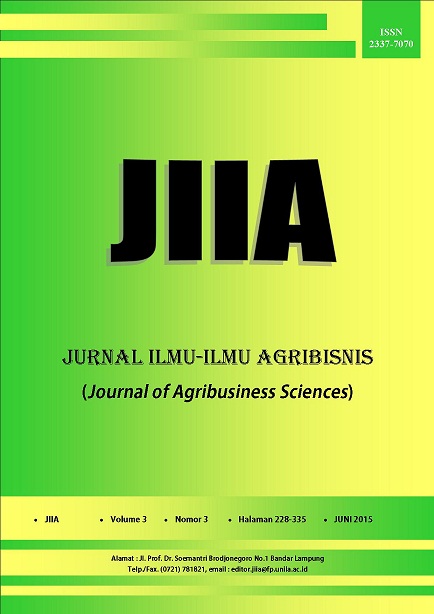ANALISIS EFISIENSI PRODUKSI DAN PENDAPATAN USAHATANI PADI SAWAH PADA LAHAN IRIGASI TEKNIS DAN LAHAN TADAH HUJAN DI KABUPATEN LAMPUNG SELATAN
DOI:
https://doi.org/10.23960/jiia.v3i3.1046 Abstract View: 1875
Abstract View: 1875
Abstract
The aim of this research was to analyze the level of production’s efficiency rice farming and level of rice farming income in the technical irrigation land and in the rainfed. The research was done in Lampung Selatan in July – September 2014. The Location of research was done in the District of Palas with consideration of the area is rice production centers in Lampung. Collection data was by using questionnaire and interview of the samples. Samples were taken random, consisting of 33 rice farmers in irrigation lands technical and 47 rice farmers in rainfed. Data were analyzed using frontier production function, and analysis of farm income. The results showed that : (1) differences in the level of production’s efficiency of rice farming in both types of irrigation between technical irrigation land and rainfed. The level of production’s efficiency in the planting season 1 by 76.33 percent for technical irrigation land and by 67,09 percent for rainfed. while in the planting season2 at the level of efficiency of technical irrigation land by 87, 81 percent and at rainfed by 69,26 percent. (2) Cash income of rice farmers planting season 1 and planting season 2 on technical irrigation land is greater than cash income rainfed rice farmers. Revenue in the first planting season, respectively Rp 15,276,139.75/ha for technical irrigation land and Rp14,965,568.58/ha for rainfed. In planting season 2, income is Rp15,426,044.69/ha for technical irrigation land and Rp11,672,920.22/ha for rainfed.
Key words : production’s efficiency, income, technical irrigated land, the rainfed land
Downloads
Downloads
Published
How to Cite
Issue
Section
License
Authors who publish with this journal agree to the following terms:
Authors retain copyright and grant the journal right of first publication with the work simultaneously licensed under a Creative Commons Attribution License that allows others to share the work with an acknowledgement of the work's authorship and initial publication in this journal.
Authors are able to enter into separate, additional contractual arrangements for the non-exclusive distribution of the journal's published version of the work (e.g., post it to an institutional repository or publish it in a book), with an acknowledgement of its initial publication in this journal.
Authors are permitted and encouraged to post their work online (e.g., in institutional repositories or on their website) prior to and during the submission process, as it can lead to productive exchanges, as well as earlier and greater citation of published work (See The Effect of Open Access).














